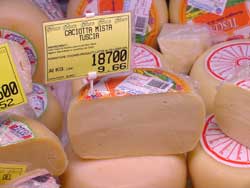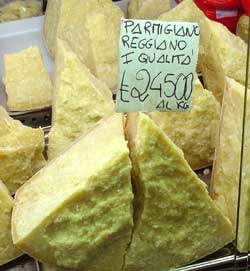
| HOME | > | BASICS |
SOME POPULAR ITALIAN CHEESES
A mild, white creamy cheese made from cow's milk. It is a modern cheese from the Lombardy region of Northern Italy. Bel Paese is very similar to the French Port Salut. It can be used to replace mozzarella in cooking.
Caciotta
Caciotta describes a wide range of simple, rural cheeses from Italy that can be made with either ewe's, cow's or sheep's milk. They are soft and mild.Fontina Val d'Aosta
One of the oldest cheeses in Italy, Fontina is dense, smooth and slightly elastic. The straw-colored interior with its small round holes has a delicate nuttiness with a hint of mild honey. When melted, as it frequently is, the flavor is earthy with a taste of mushrooms and a fresh acidity. Fontina is the primary ingredient of Italian fonduta and is a pristine table or dessert cheese. Fontina ripens in about three months and has a fat content of 45 per cent.Gorgonzola
Creamy but firm blue cheese that ranges from mild ("gorgonzola dolce") to sharp ("gorgonzola "), depending on how long it has been aged. Good in salads and for dips.Grana Padano
Grana Padano is a traditional, co-operative, unpasteurized, hard cheese. The smooth, natural rind is extremely hard and thick. This cheese is known to many of us as simply "Parmesan". The cheese should taste fresh fruity and sweet, with a hint of pineapple. The pale, yellow interior should be hard, grainy and crumbly. Grana Padano freezes very well. It ripens in 12 - 48 months.Mascarpone
A soft, white, fresh, vegetarian, cream cheese from the Lombardy region of northern Italy. In fact, it is not cheese at all, but rather the result of a culture being added to the cream skimmed off the milk, used in the production of Parmesan. It is, however, described as a curd cheese, although it is made in much the same way as yogurt. To make Mascarporne cheese tartaric acid (natural vegetable acid derived from the seed of the tamarind tree) is needed. After the culture has been added, the cream is gently heated, then allowed to mature and thicken. This whitish to straw-yellow, creamy, mild fresh cheese is compact, but supple and spreadable and it is added to famous Italian desserts, sometimes accompanied by cognac. Frequently it is used for the preparation of certain dishes and sauces. It takes only a few days to ripen and has a fat content of 75 per cent.Mozzarella
Mozzarella at its best is wonderful indeed. Mild, fragrant, delicate - combined with tomato, fresh basil and good olive oil it is a summer meal in itself. Traditionally made in southern Italy of the milk of water buffalo (introduced into Italy from India in the 16th century) - it is now made world wide from cows milk, with varying degrees of success. Special food sections will carry it, best packaged in its own salty water.Named after the town of Parma in northern Italy, Parmesan is one of the world's most popular and widely-enjoyed cheeses. Milk used for Parmesan is heated and curdled in copper containers but not before most of the milk's cream has been separated and removed. Curd is cut and then heated to 125 degrees F, all the while stirring the curd to encourage whey runoff. The curd is further cooked at temperatures of up to 131 degrees F, then pressed in cheesecloth-lined moulds. After two days, the cheeses are removed and salted in brine for a month, then allowed to mature for up to two years in very humid conditions.

Parmigiano Reggiano
Pamigiano-Reggiano is a traditional, unpasteurized, hard cheese made from cow's, skimmed milk. It has a shape of a drum with sticky, hard, yellow to orange rind. Parmigiano Reggiano weighs 75 lbs. and must be cut by a saw. The aroma is sweet and fruity, the color fresh yellow and the taste - fruity, like pineapple. Parmigiano Reggiano's flavor is unmistakably piquant. Primarily, a grating cheese, Parmigiano Reggiano is a great topping for soups, pasta dishes, veal chicken or salads. In Italy, this cheese is sold in large, grainy chunks, chiseled from the shiny drum that carries its name emblazoned on the rind. It is so valuable that trucks carrying a load of Parmigiano have been hijacked at gunpoint.Pecorino is the name given to all Italian cheeses made from sheep's milk. Pecorino Romano is the name given to cheeses from the Rome area, Pecorino Sardo is from Sardinia, Pecorino Siciliano from Sicily. It is traditional, creamery, hard, drum-shaped cheese. The smooth, hard rind is pale straw to dark brown in color. The cheese is made between November and late June. Pecorino Romano is larger than most cheeses of this type and must be pressed. It takes eight to 12 months to mature, during which time it develops its characteristic flavor - salty, with a fruity tang that becomes steadily more robust. The rind varies in color, depending on the age of the cheese, and may have a protecting coating of lard or oil. The compact interior is white to pale yellow, with irregular, small eyes. Pepato is a variety spiced with peppercorns.
Pecorino Romano
Pecorino Romano is made from sheep's milk. It is straw-white in color and has a sharper flavor than the other cheeses listed here. Although it is sometimes referred to as "Locatelli" Locatelli is a brand name of Pecorino Romano. Pecora in Italian means sheep and Pecorino Romano is one of Italy's oldest cheeses. Legend has it that a shepherd filled his flask with sheep's milk before a long trip and the motion during the trip caused the milk to naturally ferment. The idea for a new cheese was born. Today most Pecorino is made in Sardina Italy. With its fine flavor Pecorino's popularity as a grating cheese has grown significantly in the U.S. Since sheep only give milk for 6-7 months a year all production must satisfy the public's demand for the entire year.Provolone
Provolone is an all-purpose cheese used for cooking, dessert purposes and even grating. It is traditional, creamery, stretched, curd cheese. This cheese appears in various shapes. The thin, hard rind is golden-yellow and shiny. Sometimes it is waxed. Provolne cheese can be of various types. Dolce (mild Provolne) is aged for two to three months, and it is supple and smooth with a thin waxed rind. It is generally used as a table cheese. Aged for six months to two years, it is darker with small holes and a spicy flavor.Traditional, creamery, whey cheese made from cow's or sheep's milk. It is a basin-shaped cheese, pure white and wet but not sticky. Good Ricotta should be firm, not solid and consist of a mass of fine, moist, delicate grains, neither salted nor ripened. It is white, creamy and mild and is primarily used as an ingredient in lasagna. It is primarily made with cow's milk whey which is heated to 170 degrees F. Citric acid is added to encourage destabilization and separation and the temperature is quickly raised to 185 degrees F. Proteins from the whey separate rise and coagulate; the proteins (lactalbumin) are skimmed off and put in a wicker basket to drain for two days after which the "cheese" is ready for market. There are three distinct varieties of ricotta: ricotta salata moliterna (ewe's milk whey), ricotta piemontese (cow's milk whey + 10% milk) and ricotta romana (a byproduct of Romano cheese production).
Make Ricotta
Romano
One of the oldest Italian cheeses. It is made by a special method, known as "rummaging curd" or draining the curd quickly after molding, then piercing the surfaces slightly before salt is applied. In Europe, Roman is known by its original name Pecorino-Romano. The cheese has a fat content of 27 per cent and water content of 32 per cent.Copyright © 2000,2012 e-rcps.com, All Rights Reserved
